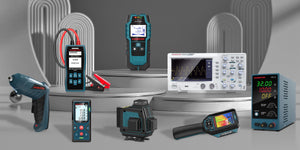
Handheld vs Benchtop Oscilloscope: Key Differences
In the world of electronics testing and troubleshooting, an oscilloscope is an indispensable tool for visualizing electrical signals over time. Whether you're a hobbyist tinkering in your garage, an engineer debugging complex circuits, or a field technician on the go, selecting the right oscilloscope can make all the difference. But with two primary categories—handheld oscilloscopes and benchtop oscilloscopes—how do you know which one fits your needs? In this guide, we'll break down the difference between handheld and benchtop oscilloscopes, focusing on key features like screen size, resolution, portability, and more. We'll also explore practical applications and recommend top models from Hanmatek to help you decide.
Understanding the Basics: What Makes an Oscilloscope "Handheld" or "Benchtop"?
At its core, an oscilloscope measures voltage as a function of time, displaying waveforms on a screen. The distinction between handheld and benchtop models boils down to design philosophy:
Handheld Oscilloscopes
Compact, battery-powered devices designed for mobility. Lightweight (often under 1 kg) and fit easily in a toolbox or backpack.

HO11 diagnosing an automotive ECU on location.
Benchtop Oscilloscopes
Larger and stationary, built for lab environments. Connect to power outlets and offer robust performance for in-depth analysis.

DOS1202 analyzing a 150 MHz RF signal with full-screen FFT.
Key Differences Between Handheld and Benchtop Oscilloscopes
1. Screen Size and Resolution: Visibility and Detail Matter
Left: HO52 3.5" 320×240 | Right: DOS1102 7" 800×480 – same noisy 50 MHz signal.
A portable/handheld oscilloscope typically features a smaller screen—often 2.8 to 3.5 inches—with a resolution around 320x240 pixels. This compact display prioritizes portability but limits how much waveform detail you can see at once. For quick checks, like verifying signal integrity in a car engine or testing a simple circuit, it's sufficient. However, for applications requiring high detail levels—such as analyzing noise in high-frequency signals or multi-channel debugging—the reduced visibility can be frustrating.
In contrast, a benchtop oscilloscope boasts a larger screen (7-10 inches or more) with high-resolution displays (up to 1024x768 or higher). This allows for clearer, more precise waveform rendering, multiple traces on screen, and advanced zooming/panning.
Pro Tip: When searching for "handheld oscilloscope" vs. "benchtop oscilloscope", remember that screen size directly ties to your use case—portability vs. precision.
2. Portability and Power: On-the-Go vs. Stationary Powerhouse

Handheld models shine in mobility. Rechargeable via USB and often running for 6-8 hours on a single charge, they're perfect for remote diagnostics. Many integrate additional functions like multimeters or waveform generators, turning them into all-in-one tools. For example, the Hanmatek HO11 Handheld Oscilloscope offers 10MHz bandwidth in a pocket-sized form, ideal for beginners or field techs.
Benchtop oscilloscopes, however, are tethered to a workspace. They draw from AC power for uninterrupted operation but weigh 5-10 kg, making them unsuitable for travel.
3. Bandwidth, Channels, and Functionality: Depth of Analysis

Handheld scopes often top out at 50-100MHz with 1-2 channels. Models like the Hanmatek HO52 3-in-1 50MHz 2CH combine oscilloscope, multimeter, and waveform generator functions.
Benchtop units offer 100-200MHz bandwidth and 2-4 channels. The Hanmatek DOS1102 110MHz 2CH delivers professional-grade performance with auto-calibration and USB connectivity.
4. Price and Accessibility: Budget vs. Investment

Handheld oscilloscopes start at $50-200. Advanced options like the Hanmatek HO102 100MHz 2CH push boundaries affordably.
Benchtop models range from $200-1000+. The Hanmatek DOS1202 200MHz is a solid mid-range choice.
| Feature | Handheld Oscilloscope | Benchtop Oscilloscope |
|---|---|---|
| Screen Size | 2.8-3.5 inches, lower resolution | 7-10 inches, high resolution |
| Portability | High (battery-powered) | Low (AC-powered, bulky) |
| Bandwidth | 10-100MHz, 1-2 channels | 100-200MHz+, 2-4 channels |
| Best For | Fieldwork, quick tests | Lab analysis, high detail |
| Price Range | $50-200 | $200-1000+ |
When to Choose Handheld vs. Benchtop: Real-World Applications

- Opt for Handheld if you're in automotive repair, HVAC, or education. The Hanmatek HO51 3-in-1 is a versatile pick.
- Go Benchtop for R&D or prototyping. The Hanmatek DOS1104 4-Channel handles multi-signal tasks effortlessly.
For hybrid needs, consider the HO52S 3-in-1 or DOS1102S with Waveform Generator.
Conclusion: Pick the Right Tool for Your Signals

HO102 handheld (left) vs DOS1202 benchtop (right) – same 100 MHz square wave, worlds apart in clarity.
The difference between handheld and benchtop oscilloscopes ultimately comes down to trade-offs: portability and affordability versus power and precision. A portable/handheld oscilloscope's smaller screen and lower resolution make it less suitable for measurement applications requiring high detail levels, but it's unbeatable for on-the-move efficiency. Benchtop models, with their expansive displays and advanced specs, are the choice for stationary, detail-oriented work.
Shop Hanmatek Oscilloscopes Now:





Dejar un comentario